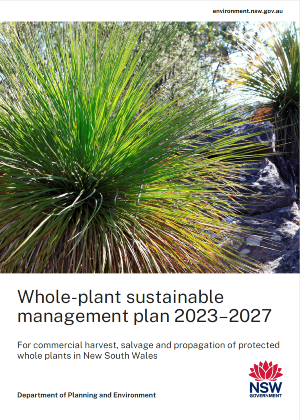Native plants are protected in New South Wales by the Biodiversity Conservation Act 2016 (BC Act).
Under the BC Act, it is an offence to pick, possess, buy or sell native plants listed in the Act for commercial purposes without a licence. These include:
- protected plant species listed in Schedule 6
- threatened plant species listed in Schedule 1
- plants from threatened ecological communities listed in Schedule 2.
It is not an offence to pick, possess, buy or sell native plant species not listed as protected or threatened in the BC Act, and licences are not required. However, there may be restrictions on clearing native vegetation in rural areas under Part 5A of the Local Land Services Act 2013 or clearing native vegetation in non-rural areas under the NSW Vegetation State Environmental Planning Policy (SEPP).
When you need a licence
You need a licence to pick or cultivate protected and threatened plant species for commercial purposes.
Types of licences
The type of licence you need to pick or cultivate protected or threatened plant species for commercial purposes depends on where and what you want to harvest.
Each type of cut flower and whole plant licence has different licensing restrictions, tagging, monitoring and record-keeping requirements.
Find out more about the different licence types, which licence you may need and how to apply:
To pick and/or cultivate protected and threatened plant species for research or conservation purposes, you need a scientific licence.
When you don’t need a licence
The legal sourcing of plant material from licensed stock or with the permission of the landowner is always required, whether you need a licence or not.
You don’t need a licence to:
- pick, possess, buy or sell native plant species not listed as protected or threatened in the BC Act
- pick, possess, buy or sell protected plants cultivated as a hobby, rather than for a commercial purpose
- pick or possess protected plants if you are an Aboriginal person using the plants for domestic purposes or on Aboriginal lands reserved under the National Parks and Wildlife Act 1974, with permission of the owners
- pick, possess, buy or sell protected and threatened plants and cut flowers obtained from a licensed harvester or grower
- possess protected and threatened plant species naturally occurring on your property
- pick protected plants cultivated on private land if you are the landholder or have the consent of the landholder
- import or export protected plants interstate that are tagged as required under the BC Act or corresponding interstate laws
- buy, sell or possess manufactured articles made from lawfully picked protected plants, including wood and oils.
Management plans
Licensing requirements for the commercial use of protected and threatened plants under the BC Act are detailed in wildlife trade management plans approved by the Australian Government under the Environmental Protection and Biodiversity Conservation Act 1999 (EPBC Act).
The Cut-flower sustainable management plan 2023–27 sets out the legislation and licensing requirements for the commercial use of protected cut flowers and foliage.
The Whole-plant sustainable management plan 2023–27 sets out the legislation and licensing requirements for the commercial use of whole protected plants.
Wildlife import and export permits
We do not approve permits to export protected and threatened plants or plant parts. The Australian Department of Climate Change, Energy, the Environment and Water is responsible for wildlife import and export permits.
This department will usually need proof that the material you intend to export has been harvested or grown in accordance with the management plans approved under the EPBC Act. In most cases, the inclusion of your BC Act licence details will be sufficient.















